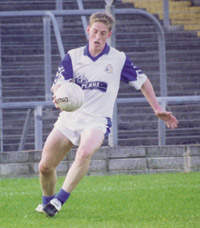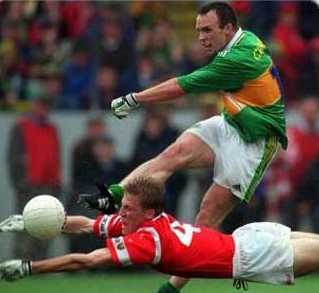Rules
Gaelic Football can be said to be a mixture of soccer, rugby and basketball, although it predates all of those games. It is a field game which has evolved along similar lines as Australian Rules football. Indeed Australian Rules football is a spin off from Gaelic Football, as the Irish game was brought to Australia by the waves of immigrants in the last two centuries. Unlike Australian Rules, Gaelic Football is played with a round ball, slightly smaller, and heavier than, a soccer ball. The playing area is a rectangular field, approx. 137 metres long, and 82 metres wide. The goalposts are the same basic shape as rugby goalposts, but the crossbar is lower than in rugby.
Teams are comprised of 15 players each. The players are named at set positions as per the diagram below, however there is no limit to the movement a player may make during the course of a game. For example, there is nothing to prevent a corner forward helping out in defence when the situation demands. The standard positioning is illustrated in this image, however in North America the full forward (14) and full back (3) positions are eliminated, making it a 13 a side game.
2. Right corner-back 3. Full-back 4. Left corner-back
5. Right half-back 6. Centre half-back 7. Left half-back
8. Midfielder 9. Midfielder
10. Right half-forward 11. Centre half-forward 12. Left half-forward
13. Right corner-forward 14. Full-forward 15.Left corner-forward
The ball is moved down the field by several methods . The main ones are illustrated here.

Kicking: The ball may be kicked from the hand, as illustrated in the first picture on the left, or from the ground at any time, and is the most common way of scoring and moving the ball. Rule infractions are also punished by a free-kick, in which a player may kick the ball from the ground, or from his hand, unimpeded by an opponent, much like a 'mark' in Australian Rules.

Hand Passing: The player in possession may elect to 'hand-pass' the ball to a team mate, or over the crossbar, especially in confined spaces when a kick could be blocked. The hand-pass is executed by holding the ball in one hand, and cleanly striking it with the other. It is important that the referee sees a clear striking motion, as throwing the ball, allowed in rugby, is not allowed and is punishable with a free kick to the opposition.

Soloing: A player in possession may carry the ball a maximum of four steps before either:
a) bouncing the ball on the gound back to himself, or
b) kicking the ball to himself (a solo).
The player may not take more than one bounce consecutively while running. He must at least alternate it with a solo every other four steps, although there is no limit on the amount of consecutive solos a player may take.A solo is one of the most difficult skills in Gaelic football, especially when performed at speed. It requires a lot of coordination and touch. It is executed by dropping the ball from the hand to the foot, and flicking it with the foot back up to the hand, all while running. In the picture to the left, a Derry player prepares to solo the ball to himself, as he drops the ball from his hand onto his foot.

Tackling: Tackling in Gaelic Football is confined to tackling the ball. i.e. it is illegal to trip, punch, hold/drag, pull or rugby tackle another player. It is legal, however, to make full body contact as long as it is a clear attempt to win the ball. Shoulder charges are allowed. The main methods of trying to dispossess a player are as follows.
a) Blocking the kick. A defender may attempt to block the ball as it leaves the attackers foot, as shown in the first picture on this page. If the ball is blocked it is considered 'loose' and players may compete for it again.
b) The defender may try to knock the ball out of the attackers grasp by hitting it with one of his hands. It is important to play the ball in this case as striking the player can result in a free-kick and also a yellow, or red card. Notice in the picture to the right how the attacker, from Armagh tries to shield the ball with his body as the Down defender attempts to dispossess him.
c) A player may jostle, or shoulder to shoulder charge, an opponent when racing to win a loose ball, or when trying to knock an opponent off the ball.
Scoring: There are two methods of scoring. Putting the ball over the crossbar and between the uprights, either by kicking or handpassing it over, is worth one point. Putting it under the crossbar and between the uprights is a goal and is worth 3 points. The goal is protected by a goalkeeper, much like a soccer goalkeeper. When the ball is in the attackers possession and control, he may only score a goal by kicking the ball. If, however, the ball is in the air , and in nobodies possession, the attacker may punch it directly to the net, like a spike in volleyball.
